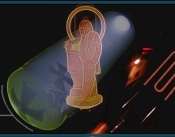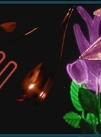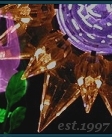Presented below is the lecture titled The William J. Hammer
Historical Collection of Incandescent Lamps by William
J. Hammer, colleague to Thomas Edison. This book was reprinted
from the Transactions of the New York Electrical Society in
1913. This work describes the most important collection of
incandescent lamps ever assembled as told from Hammer's own
perspective.
THE WILLIAM J. HAMMER
HISTORICAL COLLECTION
OF INCANDESCENT ELECTRIC LAMPS*
By William J. Hammer
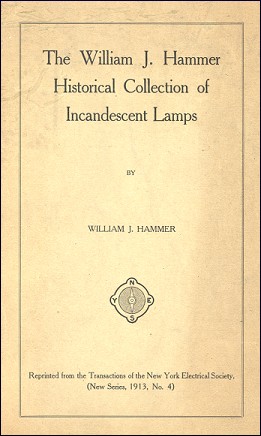
[REPRINTED FROM THE TRANSACTIONS
OF THE NEW YORK
ELECTRICAL SOCIETY, NEW SERIES, 1913, No. 4.]
It will be impossible for me to do even scant justice
to the history of the incandescent electric lamp
in the brief period assigned to me to address you
in this evening. The informal remarks, for I have
no notes, which I shall make to you this evening
will be largely confined to the "History of
an Art," which you will be able to inspect later
on the tenth floor of this building in the headquarters
of the American Institute of Electrical Engineers.
I have been engaged upon this work for about 34 years.
I trust that when we later arrive upstairs, you will
not hesitate to ask any questions and I will endeavor
to answer them to the best of my ability.
It seems essential at the outset of my remarks upon this collection
to say at least something regarding the genesis of the incandescent
electric lamp. While Mr. Thomas Alva Edison is universally recognized
as the father of the commercial incandescent electric lamp, it
is nevertheless a fact that there were incandescent electric
lamps made long before Mr. Edison's time; yes, even before he
was born.
In the year 1810 Sir Humphrey Davy, in the Royal
Institution in London, with his famous battery of
2,000 cells and his pieces of willow charcoal, formed
a 4-inch electric bow or "arc" and this
experiment laid the foundation for all subsequent "arc" lighting
systems. It is interesting to note that he was also
the founder of incandescent electric lighting, as
he at this early period made both platinum and carbon
incandescent by means of his famous battery. After
describing his experiments with the arc light, he
says, "And a platinum wire 1/30 of an inch in
thickness and 18 inches long, placed in circuit between
the bars of copper, instantly became red hot, then
white hot, and the brilliancy of the light was insupportable
to the eye."
The first English patent on the incandescent electric
lamp was that of De Moleyns in 1841. He proposed
to sprinkle finely divided carbon or graphite over
the surface of an incandescent platinum wire.
Mr. J. W. Starr, a young man from Cincinnati, Ohio,
a protege of the well known philanthropist Peabody,
in 1845 took out a patent, through his English attorney,
King, in whose name the patent appears, for a lamp
consisting of a strip of graphite in a Torricellian
vacuum. It is very interesting to note that in the
year of his death 1847 (the very year, by the way,
in which Mr. Edison was born) Starr had the privilege
of exhibiting before the immortal Faraday a chandelier,
or electrolier, of 26 of these lamps, representing
the 26 states which constituted the Union at that
time.
In 1858 Gardner and Blossom took out the first American
patent in this field, it being for a platinum lamp
to be used for a railway signal lamp. One of these
lamps may be seen today in the Patent Office Museum
at Washington, D.C.
Many men subsequently contributed to the Art, among
those of an early period being Konn, Kosloff, Bouliguine,
Lodyguine, Changy, Staite, Fontaine, Draper, Adams,
Watson, Farmer, Roberts, Sawyer, Maxim, and others;
and it is but right that we should keep these names
green in our memory because their work was work of
importance, even though it did not directly result
in the establishment of the commercial incandescent
electric lamp.
There were inherent defects in all of these lamps;
they were nearly all separable lamps. Some burned
in the open air,, and others were sealed by glass
or porcelain plates and, if exhausted, probably possessed
only a Torricellian vacuum. Torricelli discovered
that mercury in a glass tube at sea level would stand
at a height Of 30 inches when a glass tube so filled
was inverted and stood upright in a vessel of mercury.
Starr and others utilized a tube 6 or 8 inches longer
than this, filling the entire tube with mercury,
so that when the tube was inverted, as already described,
the mercury would fall until it reached the height
of 30 inches, leaving a Torricellian vacuum above
this vacuous space being utilized by some of the
early inventors for their electric lamps.
The early platinum lamps were very limited in their
possibilities; for if platinum is brought up to over
3 to 4 candles, its melting point is reached and
it softens like butter. Edison's first lamp was a
platinum lamp, but he alloyed iridium with the platinum,
as had been done by Staite before him and the use
of which bad been still earlier suggested by Petrie.
Edison found that by gradually heating the wire by
means of an electric current, then allowing it to
cool, and reheating and cooling it again many times,
he was enabled to drive out the hydrogen gas which
was occluded in the pores of the metal, and the metal
became exceedingly dense and so hard that the sharpest
file would not affect it. It was like a new metal,
and a spiral coil, which had a radiating surface
of 3 sq. in., could be raised to from 30 to 35 candle-power
without melting. A thermostatic wire placed in the
center of this spiral was attached to a short-circuiting
lever, so that an excess of current sent through
the spiral would heat and expand this thermostatic
wire, allowing its lever to touch a contact which
short-circuited the spiral. As soon as the spiral
had cooled, sufficiently, the thermostatic wire would
lift the lever, thus throwing the spiral back into
circuit again. This lamp was known as Edison's platinum-iridium
thermostatic regulating lamp.
In this early work of Mr. Edison's of 1877-1878,
he not only employed platinum in the form of wire
and foil and alloyed it with various metals, but
he did considerable work with various metallic oxides
and you will note among his early lamps his oxide
of zirconium lamp; another lamp shows a platinum
wire coated with titanium oxide.
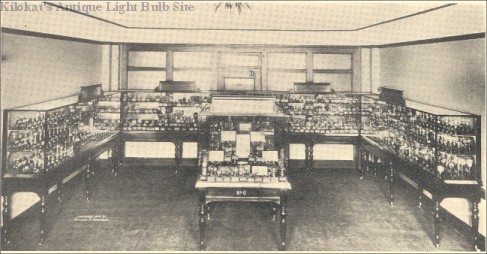
Fig. 1-General View of Incandescent
Lamp Collection.
Click on picture to enlarge
In 1879 Edison's famous "paper horse shoe" lamp
appeared, this being his first thoroughly commercial
lamp, and of which 700 or 800 were installed in the
Edison laboratory and workshops, dwelling houses
and through the streets at Menlo Park, N. J. The
filament of this lamp was cut out of a piece of bristol
board, which in carbonizing shrunk about one-third,
in size. Lamp filaments were also made of thread
rolled in tar; also from graphite and of many kinds
of vegetable fibers, such as manila, hemp, bast,
jute, bamboo, etc.
You will observe that the historical incandescent
lamp collection is contained in five cases, four
of which are ten feet in length. They are of plate
glass with glass shelves and with mirrors at the
back. In addition to these four cases, there is a
fifth in the center, which is four feet square. The
brass plates on the cases are numbered from 1 to
5 and give the periods of the Art covered by the
lamps contained in each case and the names of certain
of the inventors.
The square case No. 1 contains the earliest steps in the work
of Mr. Edison, as well as that of Swan, Lane Fox, Maxim, Sawyer,
Latimer, Changy, Crookes, Rogers, Gatehouse, British Electric,
Nothomb, Siemens & Halske, Siemens Brothers, Mueller, Gerard,
Greinert & Fredrich, Swinburne, Cruto, Bernstein, Akester,
Kurtzgen, Boehm and others. These particular lamps have been
isolated in this case as they constitute the foundation of the
Art as represented by the entire collection shown in the room.
They have been set apart just as one observes is the case in
visiting the Louvre in Paris or the Uffizzi Gallery in Florence,
where there is a special room containing a few pictures of the
greatest masters- pictures of which we have heard all our lives.
In this manner we are duly impressed by these famous works of
Art, whereas if they were scattered throughout the entire Gallery
we would not receive the same impression.
I would call your attention to a lamp in Case 1, invented by
an English butcher by the name of Rogers. In 1881-1882, in association
with Mr. Edward H. Johnson, I had the pleasure of establishing
the first central station for incandescent electric lighting
in the world at 57 Holborn Viaduct, London, England (started
up January 12, 1882). Rogers hired a place a few doors away from
the station and fitted up an exhibition of his system of incandescent,
electric lighting. In the basement he hung a number of large
copper spheres about 18 inches in diameter, inside of which were
placed smaller spheres. From these spheres, which were connected
to the dynamo machine, fine wires were run to the individual
lamps in various parts of the room. He explained to me with great
earnestness that he had made one of the most wonderful electrical
discoveries ever made, namely, that if electricity from the dynamo
were permitted to spread itself over the surface of these copper
spheres, it increased enormously in efficiency, and he was thus
able to get from "two to three lamps per horse-power more" than
Mr. Edison did. He not only believed this, but made certain investors
believe it, although the system naturally did not last very long.
Edison's various platinum wire and foil lamps and his oxide of
zirconium lamp, may be seen in this case and also his earliest
steps in the paper and vegetable fiber filaments, and bamboo
and graphite filament lamps, including the first lamp ever made
in the pear shape, which form is now practically universal.
For many years Mr. Edison used bamboo for his filaments. There
are said to be some three thousand varieties of bamboo, of which
about 400 are of some particular use, the rest being largely
weeds. He found in a certain hilly district of Japan a variety
of bamboo called "Madake" bamboo, and discovered that
when the outer calcareous surface and the inner pithy fibers
were removed, he obtained in the center one of the most perfect
cellular structures known, which produced a carbon filament of
great strength and high resistance. I have explained to you that
early inventors did not succeed in making a commercial carbon
filament lamp, which was because the early lamps utilized either
plates or rods of carbon of exceedingly low resistance, ranging
from somewhat less than 1 ohm up to 4 or 5 ohms. Edison's carbon
filament lamp had a resistance of 140 ohms hot and more than
twice that cold. Possessing such a high resistance filament,
he was enabled to connect his lamps across the electrical conductors
like rungs in a ladder, and the higher the resistance of the
filament, the more lamps he could place in parallel or multiple
before the external resistance approached the low internal resistance
of the armature, and naturally the greater the saving of copper
in the distributing system.
Among the early carbon lamps shown in Case No. 1
are many of low resistance and, frequently a number
of these were connected in series and the sets of
series lamps being then connected in parallel or
multiple. Mr. Edison aimed from the very first to
make each of his lamps an independent, self-contained
unit, con-

Fig. 2-Case 1, Showing Original
Types of incandescent Lamps.
sisting of a high resistance filament of carbon
hermetically sealed in an all-glass receptacle with
platinum leading-in wires. I wish to call your particular
attention to what seems to me an extraordinary fact,
namely, that in 1879 the Edison carbon filament lamp
was perfected and from that time until the present
day, a period of 34 years, it has stood without a
single salient feature eliminated or added.
Case No. 2 is devoted entirely to the work of Mr.
Edison on the carbon filament lamp, and supplements
the fundamental steps in his work as shown in Case
No. 1. I believe that there is not a single important
step in the work of Mr. Edison missing in this record,
which embraces about 350 lamps.
Cases Nos. 3 and 4 represent the Art under the workers contemporaneous
with Mr. Edison all over the world, the lamps being grouped chronologically.
Among them are a number of Diehl's induction lamps for use with
alternating current. In these lamps a secondary coil is placed
inside the lamp and connected to the filament, the primary coil
being wound on the outside of the globe, or the globe inserted
in such a coil. This interesting lamp, for which the early development
of the alternating current system seemed to promise great things,
has left but little impress upon the Art. Bernstein lamps are
shown in this case, in which the filaments are made by braiding
a cotton and silk cover over a mandrel or wire; this covering
was then slipped off and carbonized, forming a hollow filament
of great strength and radiating surface. In the Cruto lamp, carbon
is deposited upon a hair-like platinum wire. The inventor claimed
that he secured a hollow carbon filament by subsequently volatilizing
or fusing the platinum and leaving a hollow carbon tube.
Stopper lamps of the Westinghouse, Packard, Greene and other
types are also shown in this case. In these lamps the filament
stem is ground into the neck of the globe like a stopper in a
cologne bottle. Bitumen and other compounds and lead were used
to assist in holding the vacuum. This lamp was used by the 'Westinghouse
Company to light the World's Fair at Chicago in 1893 and was
so constructed to get around the Edison patents.
It was supposed that this stopper lamp was absolutely new at
that time, but in Case No. 2, will be found several forms of
stopper lamps which Mr. Edison made as far back as 1880.
In Case No. 4, in addition to the standard types of lamps, will
be found special classes of regulating lamps, signal lamps, sign
lamps, Christmas tree and novelty lamps, etc. I am indebted to
the Federal Sign System (Electric) of Chicago, for a neat initial
sign, here shown, in which each letter is made of an incandescent
lamp containing a number of filaments in series.
In the center of the case is a most interesting
lamp and socket, for it was used by the speaker in
the first electric sign which was ever made and which
he constructed in December, 1881 and hung up in the
Crystal Palace in London, England. It flashed the
name "Edison" by means of a huge lever
spring switch. The speaker also had the honor of
constructing the first two 'motor driven flasher" signs,
which are now so universal, the signs having been
constructed in 1883 and placed by him on top of the
Edison Pavilion at the International Health Exposition
in Berlin, the name "Edison" being flashed
letter by letter and as a whole. Other forms of sign
lamps are shown in which the letters are enameled
or etched on the outside of the globe. Another form
designed by the speaker consists of a phosphorescent
flashing lamp, in which phosphorescent material containing
a trace of radium is combined with a vehicle which
I have used for various purposes since 1902. This
material is coated on the under side of a lettered
round glass disc forming a transparent sign which
is held by clips above the lamp. The lamp itself
is flashed frequently and the phosphorescent sign
stimulated by the operation of a thermostat in the
lamp base.
The next group of lamps in this case are the regulating
lamps. Here may be seen the Ries regulating socket,
which employs a choke coil or single-coil transformer
or reactance coil, and the Wirt "Dimalite" lamp
regulator, employing resistance wire embedded in
artificial stone. Also, the Johnson "Anylite" employing
a coil of resistance wire in sections, and other
types of lamps in which two or more filaments are
operated in series or parallel or separately by turning
a key or the socket or by pulling a cord, such, for
instance. as the "Duplex," Phelps, Hylo,
Trilight, Dublglow, Economical, etc. Among these
is shown a lamp designed by the speaker in 1880,
in which two or more filaments could be placed in
parallel or series, by turning a switch. I also designed
a lamp in 1880 in which a number of filaments of
8, 10, 16, 20, 30, and 50 candle-power were placed
in one globe, and by means of a commutator on the
base of the lamp, could be regulated up and down
without employing any external resistance by merely
switching the current from one filament to the other.
Various forms of silvered reflecting and signal lamps
are shown and you will observe one which is very
badly worn which I made as far back as 1880 at Menlo
Park.
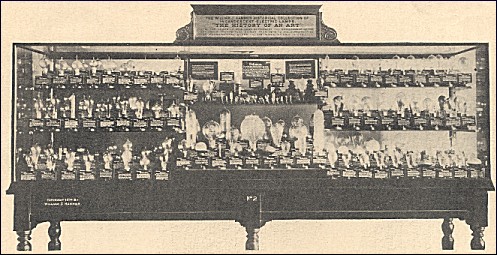
Fig. 3-Case 2, Showing Stages of
Development of the Edison Incandescent Lamp
Click on picture to enlarge
About 12 years ago a number of companies were making
what were called "tipless" or "downward" lamps.
Various types of these are shown in the collection.
At that time it was thought that getting rid of the
tip on the globe was new, but you will observe in
Case No. 1 that many of the early workers, such as
Lane-Fox, British Electric Company, Rogers, Mueller
and others made lamps which were exhausted and scaled
off at the bottom or side and were therefore tipless.
The first colored incandescent lamp ever made is
shown in Case No. 4 and the first ground glass, opal
lamp and the first etched lamp in Case No. 1.
An interesting regulating lamp is that of Thompson, of Philadelphia.
In this lamp a solenoid is placed on the inside of the lamp itself
and this solenoid, in one case, Operates a pair of springs and
in the other case, a number of carbon rollers, which place more
or less of the carbon filament in circuit as the potential varies.
This lamp is absolutely impracticable, but it is, an interesting
illustration of the efforts made to lessen breakage and blackening
of the globes due to bad regulation.
Case No. 5 illustrates the most recent developments in the Art,
as it passed beyond the carbon filament and reached the stage
of the perfected metallic oxide and metal filament lamps. The
Nernst lamp is shown in its various developments both here and
abroad from the early stages up to the present time. Also the
tantalum, osmium, dicarbide of silicon, titanium carbide, helion,
and many types of American and foreign tungsten lamps.
The tungsten lamp represents the survival of the fittest and,
although its efficiency is so great that one might say that there
is little excuse for the existence' of the other types of lamps
today, who will say that we shall not later find out something
about carbon, of which today we have no knowledge. The late Professor
Rowland once remarked that the Steinway grand piano was a comparatively
simple piece of mechanism compared to the iron atom, and the
same thing might be said regarding carbon, the constitution of
which we know comparatively little of today. In the early days
of the development of the Edison lamp, the gas people feared
that gas was about to be wiped out of existence, and some of
you may recall the great panic in gas stocks which followed the
advent of the Edison incandescent lamp at Menlo Park. The Welsbach
mantle came along later, and while it was practically a failure
at first, it was enormously increased in efficiency and improved
in color by the addition of a small percentage of oxide of cerium
to the oxide of thorium, of which the Welsbach mantle is largely
constituted. This saved the gas situation and we may see the
same thing occur in the case of the carbon filament lamp and
perhaps other lamps.
One of the things which is certain to be perfected
in the future, and I believe in the near future,
in "cold light." In Case No. 5 I have arranged
a section devoted to this subject, largely utilizing
lamps and tubes borrowed from my little laboratory,
which point toward "cold light". Among
these is a lamp consisting of a tube with a stop
cock in the center and a glass bulb at each end.
In 1902 while visiting the late Prof. Curie, who,
with Madam Curie, discovered radium, he drew a sketch
on the blackboard of this lamp and suggested that
I make one of them. If the gaseous emanation from
radium is placed in one bulb and this bulb is then
immersed in liquid air, the emanation is condensed;
when the stop cock is then opened, it passes over
into the bulb at the other end of the tube and stimulates
the phosphorescent sulphide of zinc contained therein,
which is thereby caused to give such a brilliant
light as to enable fine print to be read some distance
away.
A cathode ray lamp is also shown in which the negatively charged
corpuscles of hydrogen gas are caused to bombard a disc coated
with phosphorescent or fluorescent material, moving at a speed
of approximately 70,000 miles a second, by means of which one
may read a book at a considerable distance away.
Forms of Moore tubes are shown and also an interesting Moore
gas lamp which operates at an efficiency of about one-fourth
watt per candle. Unfortunately this efficiency soon falls to
five or six watts per candle and the lamp does not last over
200 hours. Two tubes containing Neon gas are also shown. Who
will say that we shall not find some efficient way to vibrate,
oscillate or in some way energize a gas so that it will make
an efficient transformer for electrical energy and produce an
efficient cold light? I have now in my laboratory a tube filled
with a gas which, on stimulation by a flash of current supplied
by an induction coil, becomes quite brilliantly phosphorescent,
the light persisting after the current is shut off for half an
hour or thereabouts.
Forms of Edison tungstate of calcium lamps are shown which give
considerable light when connected to an induction coil. A vacuum
tube lamp made by Mr. W. S. Andrews, of Schenectady, is shown,
in which a sheet of metal is coated with tungstate of calcium
and phosphorescent sulphide of zinc. This also gives a considerable
amount of light when connected to an induction coil.
I have made many mixtures, of radium with sulphide of zinc sulphide
of calcium, willamite, etc., utilizing these in the forms of
powdered mixtures and combined with vehicles of various kinds.
I was the first to make these in 1902, and they have been extensively
used since for watch and clock dials, etc. I also made a lamp
in 1903, which was exhibited in the St. Louis Exhibition in 1904
and is shown in the case, which glows constantly in the dark.
I have since made much better ones.
The energy efficiency of the original carbon filament incandescent
lamp was about 0.43 of 1 per cent.; that of the tungsten lamp
is somewhat over 1 per cent. (about three times that of carbon)
and there is probably no incandescent lamp that has all energy
efficiency as high as 2 per cent. On the other hand, the light
of the fire fly and the "pyrophorus noctilucus" have
an efficiency of 96.5 per cent., as shown by measurements made
by Professors Langley and Very with the bolometer and by Coblentz
with the thermopile. We shall without doubt ultimately learn
how these various creatures expend their energy and produce vibrations
that come within less than one octave of the total spectrum of
vibrations and which affect us as light. In all of our illuminants
today, most of the energy is dissipated in long heat waves, so
that what we must strive to reach is the goal of "cold light."
Now, just one word before I close regarding the formation of
this collection. I was one of Mr. Edison's early laboratory assistants
at Menlo Park, N. J., entering his employ in December, 1879.
For a considerable period I had charge of the tests
and records on the Edison lamp and subsequently became
the electrician of the first Edison lamp factory.
In the early days platinum was worth $7.00 an ounce;
today it is worth about $45.00 an ounce. It was customary
to throw the old lamps into a barrel to be smashed
in order to recover the platinum, and in endeavoring
to rescue lamps representing fundamental steps in
the Art, I met with difficulty, being frequently
told that the lamp I wanted had half a dollar's worth
or perhaps two dollars' worth of platinum in it.
But I would appeal to Mr. Edison or his very able
associates Mr. Charles Batchelor or Mr. Francis R.
Upton, and was finally allowed to form the nucleus
of this collection, over which I have, metaphorically
speaking, "sweat blood" for 34 years. About
eight years of this time I have spent in various
visits to Europe, and I have not hesitated to camp
on the trail of any man who had a lamp that I wanted.
As a result, I believe the collection does not lack
an important link.
Some 24 years ago I tried to interest a number of gentlemen.
Among them Mr. Henry Villard and Mr. Edison, in the establishment
of an engineering and technical museum in New York City, in which
engineers and inventors could place their models and records
and have then safe-guarded, but I found, however, that there
was too much inertia in this matter and I made up my mind that
I would endeavor to carry to fruition the work of completing
this collection, hoping that it would encourage others to make
similar collections forming priceless records of the inception,
development and perfection of other Arts and perhaps ultimately
result in the establishment of a great engineering and technical
museum where collections of this nature could be exhibited where
they would not only be of great interest to the general public,
but of great educational value to the student as well as stimulating
and instructive to the engineer, the inventor, the manufacturer,
the patent attorney and the historian. If my work assists in
any way in securing this desirable end, I shall feel well repaid
for my efforts.
I thank you for your courteous attention and I hope that some
time in the future I may be able to supplement this informal
address in a lecture upon the Incandescent Electric Lamp which
will be to some extent at least commensurate with the importance
of the Art and the time and attention I have devoted to it and
to its history.

[Rear Cover, click on picture to
enlarge 2mb]
*A lecture delivered at the 317th
Meeting of the New York Electrical Society, held
February 17, 1913, in the Engineering Societies
Building, New York. The magnificent collection
of incandescent electric lamps formed by Mr. Hammer
during the past thirty-four years, and comprising
over 1,000 specimens, has been secured by the Association
of Edison Illuminating Companies and is appropriately
housed in a room in the Engineering Societies Building,
New York. The lamps are skillfully arranged in
five large glass cases for convenient inspection
by visitors, each lamp being accompanied by a descriptive
card.
-end-



